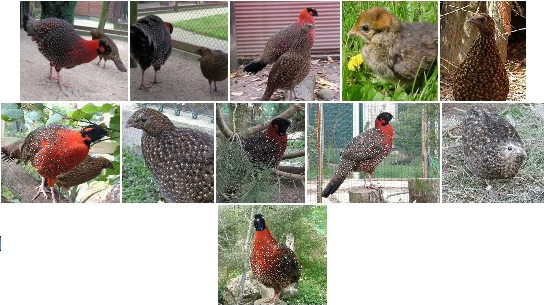Other Names: Indian Tragopan, Crimson Tragopan, Crimson-horned Pheasant.
Range: The central and eastern Himalayas.
Subspecies: None recognized.
Habitat: Mountainous forests from about 8,000 to 14,000 feet in summer and 6,000 feet in winter.
Description, Male: Head almost completely feathered and black, a band on each side of the crest, the sides of the neck, the upper back, shoulders, and upper breast, deep crimson red; rest of under parts crimson, with black and white ocelli, becoming larger and greyish on the abdomen and flanks; under tail coverts red, with brown-lined white ocelli, and two larger olive ones on the sides; longer tail-coverts brown with subterminal mottled dark brown and buff, the tip of tail black. Iris brown; bill black; bare skin of throat dark blue; lappet blue in the middle, pale green on the margins, with four or five triangular scarlet patches on each side; fleshy horns blue; the lappet extends to a length of 100 mm and the horns to 75 mm during display; legs pink. The tail is proportionally longer than other Tragopans. First year Male: Like the female, but larger and higher on the legs, with a black-head, much red on the neck and upper back, the breast more or less splashed with red, with few white ocelli.
Description, Female: Upper parts rufous to dull brown according to individual variation, with pale buff central markings and blackish vermiculations and patches; tail rufous brown with irregular black and buff bars; chin and throat pale brown or buff lined with black; under parts like the back but much lighter, particulary the abdomen where the pale center of the feathers expands into a large whitish spot. Iris brown; orbital skin bluish; bill horn brown; legs whitish grey.
Status in Wild: Listed as vulnerable, believed there are less than 20,000 remaining in the wild.
Breeding Season: April to June.
Breeding Age: Second year.
Clutch Size: 4-6.
Incubation Period: 28 days.



